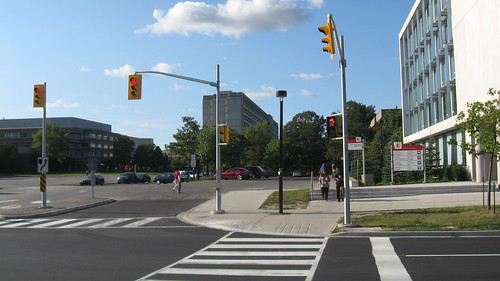
When I got off the bus at York University‘s Keele Street Campus I found it difficult to find my bearings. I got off at The Pond Road, next to an expanse of parking lots beyond which lies fields and suburban homes. Across the street there was a series of large contemporary buildings and a faded campus map. There was almost no one around, and very little to pull me in or give me a taste of the school’s character.
When York’s Keele Street campus was planned in the early 1960s, the place was meant to embody the character of historical educational institutions — secluded quadrangles and contemplative green space — but on a much larger scale, while at the same time incorporating contemporary architecture and other modes of modern living. The land the campus was built on was formerly used for agriculture, and therefore already had a pastoral quality. The architectural style that was adopted was concrete brutalism (similar to but much larger than University of Toronto Scarborough’s concrete buildings by John Andrews). To accommodate the modern ubiquity of cars, the campus was implemented with a road that ran around the school’s outer perimeter, linking to surface parking within. Cars were not meant to penetrate the campus much further than that (there were no real through-streets), the idea being that once people arrived by car and parked, they could walk into and enjoy the open green spaces at the campus’s core.
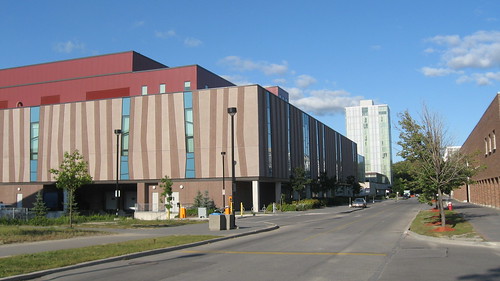
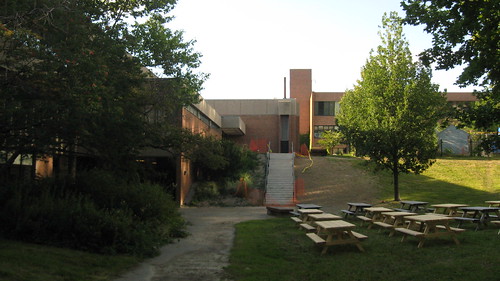
Standing on The Pond Road, the southern part of the still-existing perimeter road, I could see the influences of modernity, but not of traditional university campus planning. Eighty-five percent of York’s students commute to campus, arriving by 1,500 buses (including GO, TTC, and Viva buses) and over 30,000 cars each day. This strictly modern model of education, the commuter school, seems to have completely outweighed the notion of a traditional university. The campus’s architecture doesn’t look as though it is meant to be, or even can be, enjoyed for longer than a few hours at a time before people leave as fast as possible. Although the initial aims of the 1960s campus were eventually altered in the late ’80s and early ’90s in favour of a more dense urban-style campus, my initial impression was that traditional ideas of cohesion, fluidity, and beauty were similarly abandoned.
Walking further into the campus I started to see a pattern of traditional, albeit large, courtyards, but I felt the weight of the campus’s oversized buildings bearing down on me. York’s scale is enormous, and as the third largest university in Canada — with 7,000 faculty members and approximately 50,000 students — this doesn’t seem terribly surprising. However, this seems off compared to the University of Toronto’s St. George Campus, which accommodates a higher number of students (80% of which, similar to York, live off campus or commute) in more human-scaled buildings and within a smaller site (York is more than double St. George’s 168 acres). I couldn’t understand why the buildings at York just felt so…big.
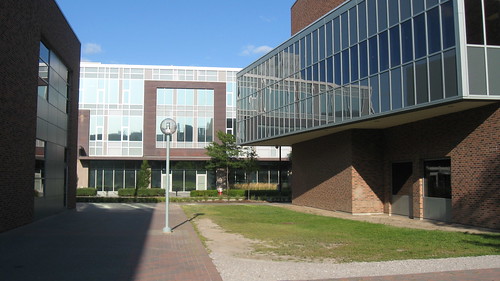

As an example, the new Seneca@York building, which opened in 1999 and was expanded in 2004, contains an interior courtyard but was built at an imposing scale — from the giant angular overhang on one side, to the open computer floor that looks like a mid-sized corporate office off the main entry hall, to the jutting bay that sits in the courtyard, dominating the space.
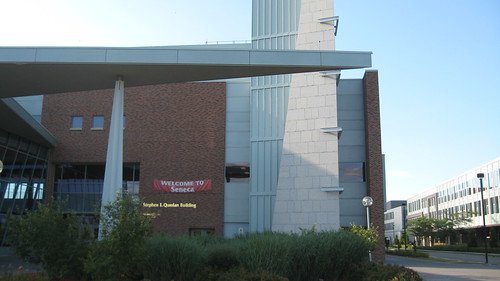
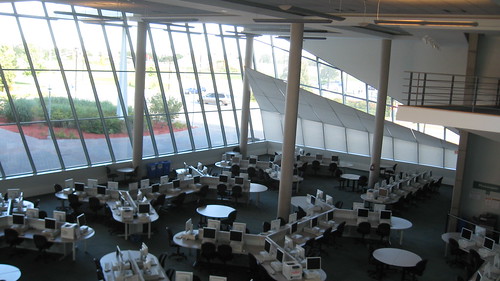
I eventually found my way to York’s more ceremonial entrance, York Boulevard, which loops around an open lawn and tranquil pond past the school’s postmodern heart, Vari Hall. Here, a few cranes are visible between buildings as evidence of construction that has been consistently adding to the campus for the last several years. Among these buildings is the new home for the Archives of Ontario, a joint development between York Univeristy and the Province of Ontario.
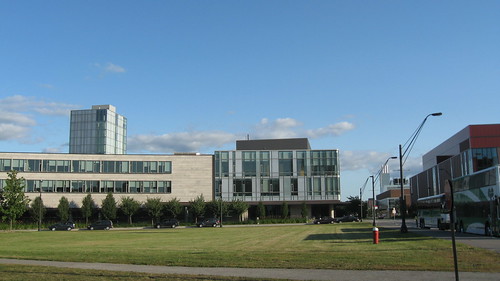
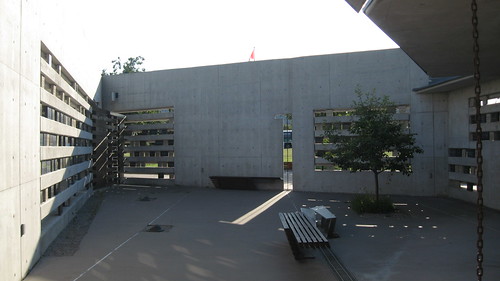
There are some interesting bits of architecture along the entry road. On one side is the Schulich School of Business building, which opened in 2003 and features an elegant stone and glass design by Toronto’s Hariri and Pontarini Architects. Facing Schulich is a curious, angular welcome centre that felt very out of place — partly because its small scale is so different from the other, very large buildings (it felt like only one or two people should be in there at a time). Also, the small, enclosed courtyard looked like it was meant to be a very contemplative space, but it sits in what basically amounts to a traffic island. The structure is called the Lorna R. Marsden Honour Court and Welcome Centre and was officially opened in 2000.
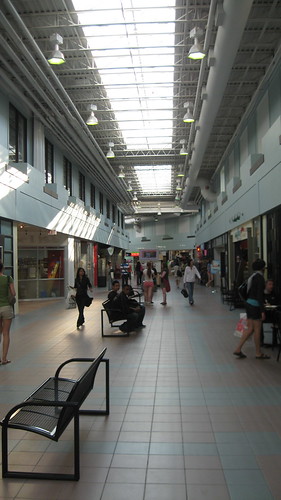
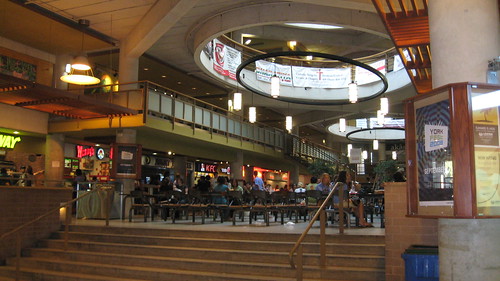
Walking further down York Boulevard I found the school’s indoor shopping mall, the York Lanes. Students were cycling in and out of different shops that include restaurants and a travel agent. Though a mall might seem like a strange thing to have on a university campus, it is probably a real benefit to many students who need something quickly, but don’t want to drive or take the bus off-campus to get it. York is relatively remote, so stores are quite distant from campus. Near the mall is the Student Centre that houses a food court, student clubs, and an art gallery. I ate lunch at the Student Centre and thought it was cool because there were so many students. It was loud and reminded me of how much energy students have, especially when they get together.


Leaving the Student Centre, I went into Vari Hall. Designed by Toronto’s Moriyama & Teshima Architects and built in the early 1990s, Vari Hall was meant to give a new urban face to the campus that many felt was suburban and sparsely populated. Vari Hall was also meant to screen the Ross Building, a concrete behemoth that formerly dominated York’s central lawn space. Vari Hall feels a little bit like a postmodern grain silo (similar to the Mississauga Civic Centre), but the building is apparently very successful, as it is a popular meeting place for students and faculty, and provides needed lecture halls, classroom spaces, and faculty offices.

Behind Vari Hall stands the Ross Humanities and Social Sciences Building. True to the original campus ideologies, there was a traditional but large courtyard in the middle. I wandered in and stood briefly until I saw the Ross Building’s horizontal tower. I made my way up to the building’s podium and stared in awe at this daring tower, with bold, projecting balconies, and glassed-in concrete bridges. Walking around the podium revealed other, equally bold concrete buildings.
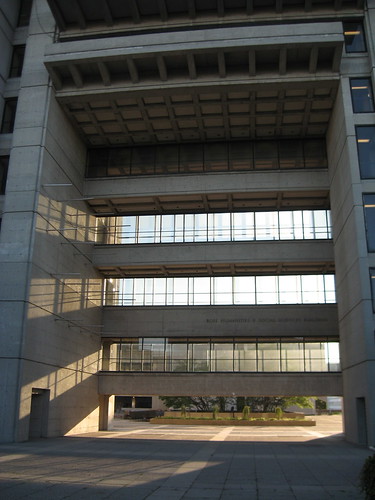

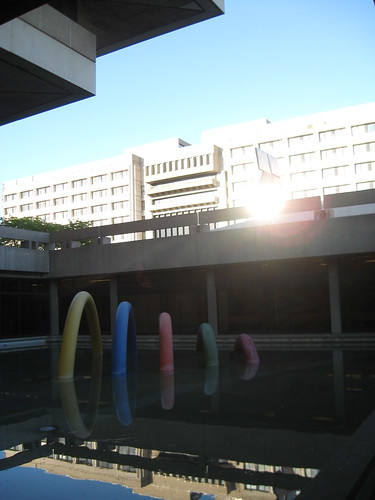
Although it felt clear that the shopping mall and student centre were way more popular — I was completely alone up at Ross Building’s podium, although lots of the roofing tiles of the podium were ripped up, so it may be under construction — I was pretty amazed, I would even say stunned, by the architecture. I don’t know if I would say that the buildings were beautiful or that they made me feel inspired, but I felt like I was wondering around some futuristic fantasy world, like in Logan’s Run. Across from the Ross Building I visited the Scott Library and its utterly gravity-defying concrete cantilevers, where each one steps out more boldly than the one below it. The pictures don’t do it justice, it was strange.
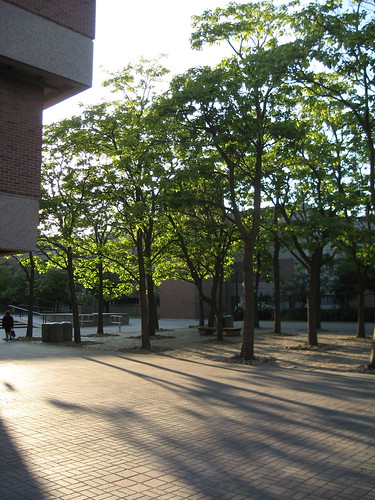
Descending from the podium and recharged about the place, I started to see York a little differently from when I first got off the bus. Further into the campus I started to break down its scale into much more manageable parts — which is what the students seem to do by taking over smaller corners and intimate spaces for volleyball games or to sit around and chat, possibly deciding which among the varied experiments in architecture and campus planning have and haven’t worked.
It is very easy to be critical of York’s Keele Street Campus, but it is also important to remember that the school was established in 1959, when experiments in urban design were thought to be revolutionary. Flemingdon Park, St. Jamestown, and Jane and Finch were all developed around the same time period, and although they might not have the same bold architectural forms as York, they were thought to offer similarly progressive models for modern living. Although none of these experiments were particularly successful in the built forms, York shapes its campus in an attempt to accommodate those using the space — in the hopes that through a long-term evolution the campus as a whole will be an interesting, unique place to study.
Although I didn’t get a chance to see it, York also has a second campus, Glendon College, in the tony Lawrence Park neighbourhood. Glendon is a bilingual liberal arts school, and the campus is set on the former estate of Edward Rogers Wood, a prominent Toronto financier during the early 1900s. Glendon was York’s first independent campus, opened in 1959, and remained a liberal arts school since the main Keele Street Campus was inaugurated in 1965. Glendon is located at 2275 Bayview Avenue.


7 comments
Great post. One of the more memorable ones in recent weeks. I spent a year at Seneca@York and used to go up to the Ross building podium to contemplate not only the vastness of York, but the vastness of Toronto. From up there, you get a sweeping view of all of the northwestern GTA – a constellation of slab apartment towers that stretch out as far as Brampton.
I understand your feelings about brutalism. My own school, the University of Ottawa, has a very brutalist library and while certainly not a beautiful building by any stretch of the imagination, every now and then I catch myself looking at it and saying to myself, “I get it!”. It may not be stately, but there is a certain something to it that catches my eye from time to time, that makes it strangely impressive and futuristic.
The Disneyland of university campuses.
I definitely encourage you to visit the Glendon campus. It’s certainly distinct from all the other college and university campuses in the GTA–an intriguing mix of modernist and historical architecture in a secluded wood overlooking the Don valley. I won’t say too much more because I think you should check it out for yourself (just take the 124 bus from Lawrence station).
I found myself thinking the same thing as Ryan while I was reading this post. Glendon is definately a secluded little gem, well worth seeing. And unlike most other campuses in the GTA, Glendon hasn’t changed at all for several decades.
Interesting post. I lived on the York Campus for four years in the mid-1980s, yet I didn’t recognize any of the photos until you got to the Ross Building and Scott Library (whatever happened to Central Square?). It would be interesting to contrast the original campus design with all those new buildings and analyse what worked and what didn’t.
Also worth looking at would be the looks of the different college buildings.
It’s interesting to read your description of the access road, as much the same has been done at the University of Waterloo, with what I would consider some success. Pedestrians, cyclists, service vehicles and transit can penetrate the inner campus easily, but those who want to park are shunted to the fringes in well-designed lots that don’t interfere with the flow of study and work. I’ve always enjoyed visiting it.